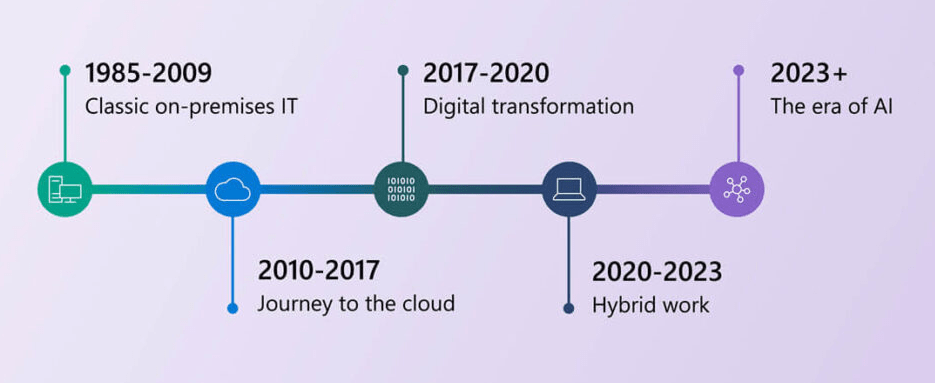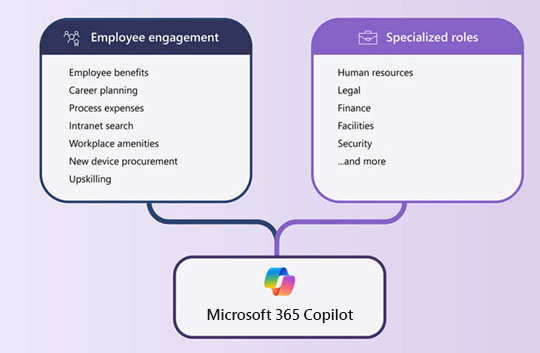As the IT team at Microsoft, we in Microsoft Digital have experienced monumental shifts in the way we build, deploy, manage, and support information technology. The most recent generational shift happened in 2020, spurred by the global pandemic and subsequent shift to hybrid work. As employees are still adapting to this new way of working, the next generational shift—human productivity augmented by generative AI—is disrupting everything again.
IT journey at Microsoft

The rapid advance of AI is enabling us to rethink every dimension of IT. From the apps, workflows, and services that power our employee experience, to the network, infrastructure and devices that power our employee productivity, everything is evolving quickly.
“The potential for transformation through AI is nearly limitless,” says Nathalie D’Hers, corporate vice president of Microsoft Digital, the company’s IT organization. “We’re evaluating every service in our portfolio to consider how AI can improve outcomes, lower costs, and create a sustained competitive advantage for Microsoft and for our customers.”
In this article, we describe some of the ways we’re already using AI, as well as new investments we’re making to accelerate our own AI-powered transformation—and to inspire yours.
{Learn how we’re reinventing the employee experience for a hybrid world here at Microsoft.Discover how we’re improving our Employee Experience as Microsoft’s Customer Zero.}
Resilient and secure infrastructure powered by AI
Reliable and secure access to corporate resources is paramount—especially at a company that has fully embraced flexible work. Our employees depend on a foundation of network connectivity to seamlessly access the tools and services they rely on every day. Harnessing the power of AI to ensure our employees stay productive and our network remains resilient and secure is one of our top investment areas in Microsoft Digital.

“AI offers a once-in-a-generation opportunity to rethink our enterprise infrastructure,” says Heather Pfluger, general manager of Infrastructure and Engineering Services in Microsoft Digital. “It’s an exciting time to be an IT leader at Microsoft as we consider all the ways IT can make our services more efficient, secure, and reliable.”
One way we’ll do that is by infusing data-driven intelligence into every part of our infrastructure, engineering, and operations to eliminate configuration drift, comply with standards and security policy, reduce operator effort and errors, and efficiently respond to rapidly changing business needs.
Investments in software defined networking and infrastructure-as-code are already improving reliability and network adaptability. AI is helping us automate workflows that deliver network services, detect anomalies, and manage compliance. We’re using real-time streaming telemetry from network devices to drive continuous operational improvements. We’ve used data from past incidents to train an AI model that will help our network engineers to reduce the time needed to mitigate infrastructure incidents with the goal of reducing or eliminating network outages and increasing employee productivity.
Securing the Microsoft network and other endpoints is critical to AI and Machine Learning (ML) are among our best tools to enhance the security and compliance of our cloud and on-premises network and hosting environments.
While Microsoft already benefits from a Zero Trust security posture, we’ll use AI and ML to further strengthen our network by automatically assigning devices to the right network, removing the burden on IT admins to classify and assign networks manually. We’ve implemented consistent access controls for wireless and wired networks to further improve security and reduce legacy VPN usage. We’re also building AI and ML capabilities to automate our security workflows, including analyzing device vulnerabilities, detecting anomalous firewall traffic flows, and managing incident diagnosis and remediation.
A vast network of interconnected devices running many different operating systems relies on our network for seamless connectivity. Managing these devices requires significant time and resources. To better manage them, we’re investing in a range of new AI-powered device capabilities spanning the entire device lifecycle.
AI-powered predictive maintenance and intelligent troubleshooting is a key investment area. We’ll use AI and ML to schedule essential maintenance tasks and autonomously fix errors and performance issues. This will reduce downtime, prolong device lifespans, and ensure employees have a consistent and productive experience by avoiding problems and errors. We’ll also use AI to analyze device settings, network activity, vulnerabilities, and user behavior, enhanced with demographic data and location metadata to offer relevant solutions for common and emerging device problems. We aim to help IT administrators be more productive through quicker decisions about device replacement, software updates, capacity increases, and other common support scenarios.
{Learn how we’re moving Microsoft’s global network to the cloud with Microsoft Azure. Discover How AI will impact the future of security.}
Employee experiences enhanced with AI
AI enables possibilities to simplify the employee experience in unprecedented ways. Our vision in Microsoft Digital is to use AI to simplify the employee experience by providing a single endpoint for most common tasks. We envision a workplace where AI seamlessly integrates into our employees’ workflows and simplifies the number of systems they must learn and navigate. We’re working to deliver a unified, connected, and personalized experience where our employees can access critical data, tools, and insights, all from one place.
“We see AI as the key to unlocking the full potential of our employees,” says Sean MacDonald, partner director of Employee Productivity in Microsoft Digital. “AI enables us to deliver personalized experiences that empower our employees to work smarter, faster and happier.”
With Microsoft 365 Copilot Chat as a central engagement hub, we’ll redesign the employee experience to no longer be app centric, but rather employee centric, to meet people in the flow of their work.
Navigating with Microsoft 365 Copilot Chat

Our employees will discover information and services through natural language Q&A to complete tasks more smoothly. Copilot Chat will support a range of different employee experiences like diving into employee benefits, facilitating career planning, processing expenses, finding information, exploring workplace amenities, purchasing devices, or upskilling for a new role. We’ll connect different Copilot features and our internal data to Copilot Chat and reduce the time to get answers or insights by more than half. Our employees can still use web or app experiences if they prefer, but Copilot Chat will become a primary entry point for many workflows.
Generative AI will also change how our employees experience support services. We aim to increase employee productivity by addressing IT issues automatically or remotely through AI-powered chats that often don’t require an agent.
{Learn more about how we’re deploying Microsoft 365 Copilot at Microsoft. Discover how Microsoft Digital is reinventing employee productivity in the hybrid workplace.}
AI-powered transformation powered by good governance
We’re working to strike the right balance with AI—we want to use it to transform the way we work and to empower our employees while also protecting the company. To get this right, we’re laser focused on adopting the right governance measures.
“We’re going to be one of the first organizations to really get our hands on the whole breadth of AI capabilities,” says Matt Hempey, a principal group product manager in Microsoft Digital. “It will be our job to ensure we have good, sensible policies for eliminating unnecessary risks and compliance issues.”
Our team in Microsoft Digital manages some of the most complex Microsoft productivity tenants in the world, and the governance of those tenants can be a challenge. Unmanaged assets like Power BI workspaces, Power Apps, or even Microsoft Teams groups increase the risk of oversharing sensitive data and can compromise the health and security of the environment. AI will be instrumental in helping us manage our tenants more effectively by helping us to detect issues and by automating time-consuming compliance tasks.
High-quality enterprise data with strong data governance is another key to our AI-led transformation. We’re establishing processes and frameworks to ensure data quality, with assigned data owners to supervise them. We’re using tools to measure data quality and produce a quality score, enhancing confidence and trust among users so they can be confident using the data in AI scenarios.
However, high-quality data is useless without ongoing governance.We have years of experience managing Microsoft’s vital tenants, and we’ve experienced the complexities of governance at global enterprise scale. AI raises issues around privacy, reputation, and copyright. Responsible and ethical applications of AI, powered by effective data governance, are our priority, so that we as a company can keep innovating without risking security or reputational damage. Using tools like Microsoft Purview, we’ll pay attention to the source, sensitivity, and lifecycle of data for AI, focusing on discovery, classification, and protection. Our goal is to safely handle sensitive data, ensuring ethical uses to achieve the right business outcomes.
{Discover how Microsoft Digital is governing its key productivity tenants to support AI. Find out how data and AI are driving our transformation.}
Transforming our approach to IT
In Microsoft Digital, we’re committed to innovating with AI to revolutionize our employee experience and to rethink IT management, work that we’ll power through consistent governance practices and high-quality enterprise data.
“From making our employees more productive to improving their experience in the hybrid workplace, to preemptively anticipating issues with our services, infrastructure, and devices, AI is fundamentally changing how we manage information technology at Microsoft,” D’Hers says.
As we’ve done since the early days of IT at Microsoft, we’ll push boundaries to become a catalyst for AI innovation for our employees and for our customers. Just as we helped shape the past three decades of enterprise IT innovation, the next steps we take on our IT journey here at Microsoft will help shape this new era of AI. We’re excited to continue sharing our insights from our journey of AI-powered transformation with our customers and partners.

Here are some learnings that we hope will help you in your journey to transform your approach to IT with AI:
- AI has the potential to revolutionize every facet of IT administration and the employee experience. Microsoft 365 Copilot Chat can increase employee productivity by making information easier to find and by reducing or eliminating repetitive and mundane tasks, which will enable your employees to focus on higher value work.
- Enterprise data is your most valuable asset in the era of AI. Invest in data and tenant governance so you can use your data to support AI-powered productivity and collaboration workloads using Azure OpenAI and other services. Microsoft Purview offers a great solution to protect your sensitive enterprise data.
- We’ll be using the power of AI to rethink our entire IT portfolio here in Microsoft Digital. As Customer Zero for some of Microsoft’s most important products for IT professionals, our insights and product enhancements will improve the experience for our customers as well.

- What is Azure OpenAI Service?
- Learn about Azure OpenAI Service.
- Get started with Microsoft 365 Copilot Chat.
- Learn how we’re reinventing our employee experience for a hybrid world here at Microsoft.
- Discover how we’re improving our employee experience as the company’s Customer Zero.
- Find out how data and AI are driving our transformation.
- See how we’re getting the most out of generative AI at Microsoft with good governance.






